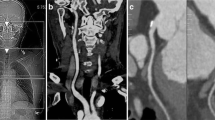Abstract
Purpose
To compare conventional CT angiography (CTA) and CTA reconstructed from CT perfusion source data (perfusion CTA) acquired on a 320-section CT scanner for the evaluation of intracranial arteries.
Materials and methods
Our study included 7 patients who had undergone trapping of an intracranial aneurysm and placement of a bypass. All underwent conventional and perfusion CTA and digital subtraction angiography (DSA). Using DSA as the gold standard, 2 radiologists evaluated 10 arterial segments on conventional and perfusion CTA images. On a 4-point scale they independently scored the image quality and vascular visualization of the intracranial arteries on the conventional and perfusion CTA images. The effective radiation dose to each patient was also recorded.
Results
A total of 65 arterial segments without apparent abnormalities were assessed. While the mean image quality score tended to be slightly higher for conventional than perfusion CTA, there was no significant difference. The effective dose for perfusion and conventional CTA with unenhanced CT was 4.2 mSv and 3.1 mSv, respectively, for all patients.
Conclusion
For the evaluation of intracranial arteries using DSA as the gold standard, perfusion CTA yields image quality and vascular visualization similar to conventional CTA at an acceptable radiation dose.




Similar content being viewed by others
Abbreviations
- CTA:
-
CT angiography
- CTP:
-
CT perfusion
- CBF:
-
Cerebral blood flow
- CBV:
-
Cerebral blood volume
- MTT:
-
Mean transit time
- DSA:
-
Digital subtraction angiography
References
Silvennoinen HM, Hamberg LM, Lindsberg PJ, Valanne L, Hunter GJ. CT perfusion identifies increased salvage of tissue in patients receiving intravenous recombinant tissue plasminogen activator within 3 hours of stroke onset. AJNR Am J Neuroradiol. 2008;29:1118–23.
Provenzale JM, Shah K, Patel U, McCrory DC. Systematic review of CT and MR perfusion imaging for assessment of acute cerebrovascular disease. AJNR Am J Neuroradiol. 2008;29:1476–82.
Turk A, Magarik JA, Chaudry I, Turner RD, Nicholas J, Holmstedt CA, et al. CT perfusion-guided patient selection for endovascular treatment of acute ischemic stroke is safe and effective. J Neurointerventional Surg. 2012;4:261–5.
Konstas AA, Wintermark M, Lev MH. CT perfusion imaging in acute stroke. Neuroimaging Clin N Am. 2011;21:215-38, ix.
Sanelli PC, Jou A, Gold R, Reichman M, Greenberg E, John M, et al. Using CT perfusion during the early baseline period in aneurysmal subarachnoid hemorrhage to assess for development of vasospasm. Neuroradiol. 2011;53:425–34.
Wintermark M, Ko NU, Smith WS, Liu S, Higashida RT, Dillon WP. Vasospasm after subarachnoid hemorrhage: utility of perfusion CT and CT angiography on diagnosis and management. AJNR Am J Neuroradiol. 2006;27:26–34.
Ramli N, Rahmat K, Mah E, Waran V, Tan L, Chong H. Use of permeability surface area-product to differentiate intracranial tumours from abscess. Biomed Imaging Interv J. 2009;5:e6.
Ding B, Ling HW, Chen KM, Jiang H, Zhu YB. Comparison of cerebral blood volume and permeability in preoperative grading of intracranial glioma using CT perfusion imaging. Neuroradiol. 2006;48:773–81.
Frolich AM, Psychogios MN, Klotz E, Schramm R, Knauth M, Schramm P. Angiographic reconstructions from whole-brain perfusion CT for the detection of large vessel occlusion in acute stroke. Stroke. 2012;43:97–102.
Cohnen M, Wittsack HJ, Assadi S, Muskalla K, Ringelstein A, Poll LW, et al. Radiation exposure of patients in comprehensive computed tomography of the head in acute stroke. AJNR Am J Neuroradiol. 2006;27:1741–5.
Tomizawa N, Kanno S, Maeda E, Akahane M, Torigoe R, Ohtomo K. Minimizing the acquisition phase in coronary CT angiography using the second generation 320-row CT. Jpn J Radiol. 2014;32:391–6.
Christner JA, Kofler JM, McCollough CH. Estimating effective dose for CT using dose-length product compared with using organ doses: consequences of adopting International Commission on Radiological Protection Publication 103 or dual-energy scanning. AJR Am J Roentgenol. 2010;194:881–9.
Siebert E, Bohner G, Dewey M, Masuhr F, Hoffmann KT, Mews J, et al. 320-slice CT neuroimaging: initial clinical experience and image quality evaluation. Br J Radiol. 2009;82:561–70.
Hulme KW, Rong J, Chasen B, Chuang HH, Cody DD, Wong FC, et al. A CT acquisition technique to generate images at various dose levels for prospective dose reduction studies. AJR Am J Roentgenol. 2011;196:W144–51.
Saake M, Goelitz P, Struffert T, Breuer L, Volbers B, Doerfler A, et al. Comparison of conventional CTA and volume perfusion CTA in evaluation of cerebral arterial vasculature in acute stroke. AJNR Am J Neuroradiol. 2012;33:2068–73.
Hayashida E, Sasao A, Hirai T, Hamasaki K, Nishi T, Utsunomiya D, et al. Can sufficient preoperative information of intracranial aneurysms be obtained by using 320-row detector CT angiography alone? Jpn J Radiol. 2013;31:600–7.
Funama Y, Utsunomiya D, Taguchi K, Oda S, Shimonobo T, Yamashita Y. Automatic exposure control at single- and dual-heartbeat CTCA on a 320-MDCT volume scanner: effect of heart rate, exposure phase window setting, and reconstruction algorithm. Phys Medica. 2014;30:385–90.
Nitta N, Ikeda M, Sonoda A, Nagatani Y, Ohta S, Takahashi M, et al. Images acquired using 320-MDCT with adaptive iterative dose reduction with wide-volume acquisition: visual evaluation of image quality by 10 radiologists using an abdominal phantom. AJR Am J Roentgenol. 2014;202:2–12.
Yamashiro T, Miyara T, Honda O, Kamiya H, Murata K, Ohno Y, et al. Adaptive Iterative Dose Reduction Using Three Dimensional Processing (AIDR3D) improves chest CT image quality and reduces radiation exposure. PLoS ONE. 2014;9:e105735.
Tabuchi S, Nakajima S. Usefulness of 320-row area detector computed tomography for the diagnosis of cystic falx meningioma. Case Rep Oncol. 2013;6:362–6.
Wang R, Yu S, Alger JR, Zuo Z, Chen J, Wang R, et al. Multi-delay arterial spin labeling perfusion MRI in moyamoya disease–comparison with CT perfusion imaging. Eur Radiol. 2014;24:1135–44.
Conflict of interest
None.
Author information
Authors and Affiliations
Corresponding author
About this article
Cite this article
Kidoh, M., Hirai, T., Oda, S. et al. Can CT angiography reconstructed from CT perfusion source data on a 320-section volume CT scanner replace conventional CT angiography for the evaluation of intracranial arteries?. Jpn J Radiol 33, 353–359 (2015). https://doi.org/10.1007/s11604-015-0429-y
Received:
Accepted:
Published:
Issue Date:
DOI: https://doi.org/10.1007/s11604-015-0429-y




